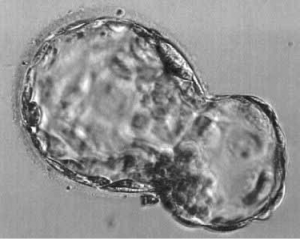About Fertility
Laser Assisted Hatching of Vitrified Embryos
A human egg or oocyte is surrounded by an outer protective shell known as the zona pellucida. As an embryo develops from zygote (day 1) to blastocyst (day 5), the outer zona progressively thins (see photos of day 3 embryo with thicker zona and day 5 blastocyst with thin zona). This ultimately enables the embryo to “hatch” out of the shell and implant within the endometrial wall.
Day Three 8-cell embryo
Arrow indicated zona pellucida

Day 5 Blastocyst (Note thinner outer shell/zona pellucida)

Hatching Blastocyst

When an embryo is cryopreserved or vitrified, it is thought the outer shell may change as a result of the freezing process. If it becomes brittle or hardened and is without progressive thinning, a normal embryo may not be able to hatch and permit implantation.
Laser assisted hatching is a technique used to mechanically thin or vaporize a portion of the outer zona pellucida. This breach or thinning of the zona is done to aid the egress of the blastocyst from the outer shell to the endometrium. A video of this technique can be seen here. A prospective randomized study published in Reprod Biomed Online (Apr 2008 16(4):589-96) evaluated the impact of assisted hatching on fresh and frozen-thawed embryos. A total of 760 fresh embryo transfer cycles and 200 frozen-thawed embryo transfer cycles were randomly assigned to either receive or not receive assisted hatching. In fresh embryo cycles, there was not a significant difference with assisted hatching. However, in the frozen embryo groups, clinical pregnancy and implantation rates were significantly greater in the assisted hatching group.
At the Fertility Centers of New England, laser assisted hatching is offered and recommended for frozen embryo transfers.
Have questions? We want to hear from you! Email us today!


